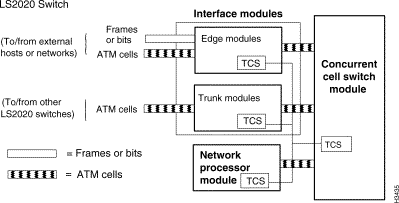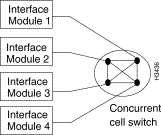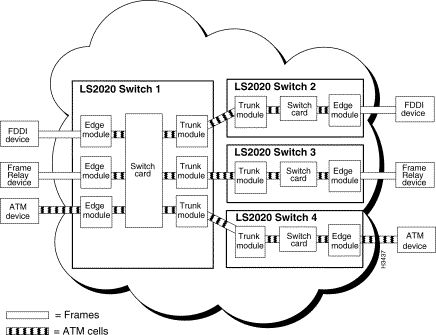|
|

This chapter introduces the LightStream 2020 multiservice ATM switch (LS2020 switch) and describes its structure and key features. Users whose duties require monitoring, configuring, controlling, and troubleshooting an LS2020 chassis or network will benefit from reading this chapter.
The LS2020 switch is a powerful backbone, multiservice ATM switch used in local and wide area networks. As an integral part of Cisco Systems' product offerings, the LS2020 provides capabilities in both ATM and fastpacket switching applications, enabling it to handle Frame Relay, circuit emulation, and LAN traffic with equal facility. In addition, the LS2020 switch provides FDDI and Ethernet switching capabilities.
You can use the LS2020 switch as a basic building block to create mission-critical, enterprise backbone networks that provide the following capabilities:
The LS2020 switch interoperates with Cisco Systems' family of internetworking products and can be combined with the LightStream 100, LightStream 1010, and Cisco ATM network interface cards (NICs) to form an end-to-end ATM network. With the LS2020 and other Cisco Systems internetworking products, you can implement complete networking solutions, regardless of the type of internetworking technology selected.
Growing demands on computers and communications systems have begun to overburden existing networking systems and technologies. For example, in the 1970s, 1.2 kilobits per second (Kbps) was considered a nominal speed, while 9.6 Kbps was considered high speed.
In the 1990s, networks using fiber optic technology are reaching speeds of 100 megabits per second (Mbps) and beyond. Also, the widespread use of applications that demand large quantities of data are stressing existing LAN/WAN systems. Such applications include distributed supercomputing, high-resolution graphics (CAD/CAM, imaging, etc.), scientific visualization, network-based client/server computing, video conferencing, and distributed file transfer/access.
Such advances have created the need for new network architectures and infrastructures that provide higher throughput, greater bandwidth, and a broader range of communications services. The LS2020 switch was designed with these needs in mind.
In addition to being based on ATM technology, the LS2020 switch has several features that make it reliable and cost-effective for high-speed, broadband, open networking applications. These features are described in the following sections.
Most LS2020 switching and communications functions are performed at wire speed in specially-designed application-specific integrated circuits (ASICs). Thus, the complement of hardware and firmware in an LS2020 switch eliminates much of the overhead associated with software-based communications processing.
The entities that perform LS2020 processing tasks are divided into three general classes, based on the speed required for the task:
Today's networks encompass a wide variety of applications, each with its own performance requirements. For example, one application may need a level of service in which cell delay variation must be minimized (as in constant bit rate voice applications). Another application may require service that is more cost-effective, but not as delay-sensitive. The LS2020 switch optimizes application performance by providing services appropriate to the application.
LS2020 switches provide cost savings by minimizing the transmission bandwidth needed from common carriers and Internet service providers (ISPs). The extent to which an ATM switch lowers carrier costs and Internet access costs depends primarily on the switch's congestion avoidance mechanisms. The LS2020 allows very high line utilization while maintaining user service guarantees.
For example, the LS2020 switch uses ControlStream, a traffic management application that controls traffic at the edges of the network. This application embodies congestion avoidance, traffic shaping, and traffic policing capabilities that allow network links to operate at high levels of utilization by scaling back lower-priority, delay-tolerant traffic at the edges of the network when congestion begins to occur.
When an LS2020 network detects congestion, the causes of the congestion are identified and controlled individually, based on user service guarantees. Thus, traffic congestion is eliminated at the source. Consequently, link use is maximized, and mission-critical service is maintained in an LS2020 network.
The LS2020 switch incorporates the following mission-critical features:
You can manage an entire LS2020 network using StreamView, an SNMP-based network management application that runs on a Sun SPARCstation. StreamView consists of three GUI-based network management tools that allow you to configure and monitor LS2020 nodes and to display the topology (a graphical representation) of all the managed objects (LS2020 nodes) in your network.
A command line interface (CLI) is also provided that you can invoke from a terminal attached to the console port of an LS2020 switch. In this case, the CLI runs on the network processor (NP) card of the LS2020 switch. In addition, the CLI can be run on a Sun SPARCstation to perform a full complement of network management tasks.
When used to run StreamView or the CLI, the Sun SPARCstation (an engineering workstation) serves as a powerful and effective network management system (NMS), allowing you to manage a defined segment or all of an LS2020 network.
In addition to StreamView, you can run HP OpenView network management software on the NMS, or you can use any other available SNMP-compatible network management application to manage your network. With such applications, you can perform a variety of network management tasks.
Other options are also available in using the CLI. For example, you can also invoke the CLI through the modem port on the console/modem assembly in the rear of the LS2020 chassis, or you can initiate a Telnet connection from a Sun workstation (or other local device) to an LS2020 node elsewhere in the network through which you can perform remote CLI network management functions.
Telnet is a standard terminal emulation protocol that is used for remote terminal connection. Telnet enables a user to log into a remote system and to use its resources as though it were directly connected.
For a full description of the network management options typically available in an LS2020 network, see the section entitled "Network Management Methods" in the chapter entitled "Network Management."
Commensurate with the need for expanded services and greater integration, an LS2020 network offers a variety of services in carrying diverse traffic over the network. These services include the following:
The LS2020 also offers VirtualStream, a LAN workgroup architecture implemented on the LS2020, that allows you to do the following:
An LS2020 network provides a clear migration path to ATM cell relay services using your existing equipment. In addition, the LS2020 provides services that make it backward compatible with any current equipment that handles the following traffic types, networking technologies, and communications protocols:
An LS2020 switch can accept a variety of traffic types from an external device, convert the traffic into ATM cells, and pass the cells through the network. The LS2020 switch also accepts ATM cells directly from an external device and passes them in like manner through the network.
The LS2020 switch provides services that allow it to support a variety of network interfaces and physical media types. Furthermore, as more ATM devices become available, you can add them to your network without adding new protocols or disrupting existing operations.
The LS2020 hardware architecture incorporates the major elements shown in Figure 2-1:
Together, these modules provide the functions required to receive frames, bits, or ATM cells from external devices and to transfer this data as ATM cells across an ATM network. The following sections describe these modules.

In an LS2020 switch, the concurrent cell switch module consists of a switch card and a console/modem assembly. The switch card contains the concurrent cell switch, which interconnects all interface modules and NP modules. The console/modem assembly provides the physical interfaces for the console (terminal) and modem ports on the switch card.
In an LS2020 chassis, you can connect up to nine interface modules with one NP module, or you an connect up to eight interface modules with two NPs.
Figure 2-2 shows the architecture of the concurrent cell switch module.

In a concurrent cell switch, each interface module or NP is interconnected with every other interface module or NP module through a concurrent cell switch function that allows multiple transactions to occur simultaneously among all modules.
The use of many parallel paths allows the aggregate throughput of an LS2020 switch to be extremely high, without requiring the speed of each individual interface module to match the aggregate speed.
The concurrent cell switch function supports ten input ports and ten output ports. Each output port has two channels to reduce the probability that data passing through the switch will be blocked. The total bandwidth on each port is 200 Mbps in full-duplex mode. Allowing for cell headers and switch contention (more than two switch input lines contending for the same output line), this bandwidth capability provides a sustained payload throughput of approximately 160 Mbps in full-duplex mode.
All switch ports can pass traffic simultaneously, resulting in a peak transfer rate of 2 Gbps and an aggregate sustained payload throughput of 1.6 Gbps.
The network processor (NP) module consists of an NP card, an NP access card, and a disk drive assembly. The NP module supports RouteStream, a highly sophisticated distributed network routing protocol.
NP functions include the following:
The NP access card incorporates an Ethernet interface for the NP module, making it possible for a network management station (NMS) to attach to an LS2020 network that has no LAN interface modules.
Each NP module also has an associated disk drive assembly that incorporates a floppy disk drive and a hard disk drive. The floppy disk drive is used to load new NP and interface module software, while the hard drive contains system software, LS2020 boot, configuration, and routing information, and general-purpose storage space.
Interface modules provide two types of services in an LS2020 switch:
An LS2020 switch can handle traffic in the form of frames, ATM cells, or constant bit rate data streams received from external devices.
If the traffic from an external device is in the form of frames, the edge module parses the incoming frames (segments the frames into ATM cells), determines the connection on which the traffic should be sent, and transmits the cells across the network. At the receiving end of the connection, the edge module reassembles the ATM cells arriving from the network, arranging the cells into the original data frames and passing them from the edge interface to the user's external device.
If the traffic from an external device is in the form of ATM cells, the edge module examines the connection identifiers in the headers of the incoming cells and determines the connection on which the ATM traffic should be forwarded. It then transmits the cells intact across the LS2020 network, since no cell segmentation or reassembly of the data is required. The edge module at the receiving end of the connection accepts ATM cells from the LS2020 network and transmits them from the edge module to the user's external device.
If the traffic from an external device is in the form of constant bit rate data, the edge module segments the stream into ATM cells, much in the same manner as is done with frame data, and propagates the cells through the network. The edge module at the receiving end of the connection reassembles the cells into the original bit stream (preserving bit sequence and timing) and transmits the stream from the edge module to the user's external device.
Each edge module contains an onboard control processor that works in conjunction with the NP to set up new connections and provide low-level control information required by the LS2020 network management system.
The edge modules for the LS2020 switch include the following:
The second-generation low-speed interface module is functionality equivalent to the predecessor module, but, in addition, it offers lower cost and higher performance.
Both versions of the second-generation T3/E3 interface modules are functionality equivalent to the predecessor module, but, in addition, they offer lower cost, greater port density, and higher performance.
Trunk modules connect one LS2020 switch with another LS2020 switch in the network, thereby forming a trunk. All traffic passed between trunk modules is in the form of ATM cells.
A trunk establishes both physical and logical connections between two ATM switches across which traffic can flow in an ATM network. An ATM backbone may consist of many such trunks.
The trunk module receives cells from a trunk line, recognizes the connection on which the cells arrive, determines the connection on which the cells should be forwarded, and routes the cells accordingly to the next LS2020 switch in the network.
Many such LS2020 switches can participate in an end-to-end ATM connection between data senders and receivers; each switch functions as a link in the overall chain of connectivity between the communicating ATM peers.
Trunk modules for the LS2020 switch include the following:
The second-generation low-speed interface module is functionality equivalent to the predecessor module, but, in addition, it offers lower cost and higher performance.
Both versions of the second-generation T3/E3 interface modules are functionality equivalent to the predecessor module, but, in addition, they offer lower cost, greater port density, and higher performance.
The test and control system (TCS) is a fully integrated, autonomous computer system that is incorporated into each NP module, interface module, and switch module in an LS2020 chassis.
The TCS communications path is completely separate from that of the LS2020 switch proper. As long as the TCS components have power and are operational, they function independently from the other modules in the LS2020 chassis.
The TCS has two primary functions:
Figure 2-3 shows four LS2020 switches connected in an LS2020 network. External devices are connected to the LS2020 switches by edge modules, and traffic passing between the user's external devices and the edge modules is packaged as frames or ATM cells. Trunk modules connect LS2020 switches to each other. Traffic passing between the LS2020 switches (or between any two cards within an LS2020 switch) is passed as ATM cells.
Note For simplicity, Figure 2-3 does not show the NPs in each LS2020 switch. Each LS2020 switch must have an NP to enable the switch to establish connections (links) throughout the network and to perform other network processing and control functions.
Note that traffic entering the network from an ATM device is passed through the entire network as ATM cells from source to destination.

The LS2020 switch adheres to the ATM specifications in existence or being developed by ITU-T, ANSI, and the ATM Forum (see Table 2-1), allowing it to interoperate with a wide range of standards-based, high-speed ATM networking devices and protocols. However, not every detail of every standard has been implemented.
The LS2020 switch complies with the SNMP specification, enabling it to be managed by any SNMP-compatible network management application.
Table 2-1 Major Standards Observed by LS2020 Switch
![]()
![]()
![]()
![]()
![]()
![]()
![]()
![]()
Posted: Wed Jan 22 23:45:25 PST 2003
All contents are Copyright © 1992--2002 Cisco Systems, Inc. All rights reserved.
Important Notices and Privacy Statement.